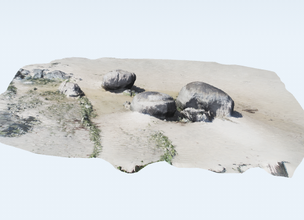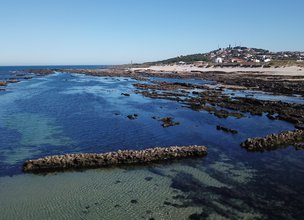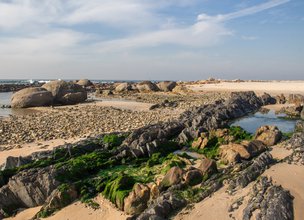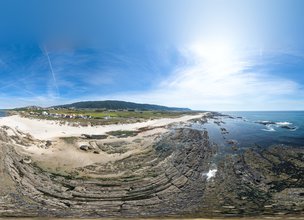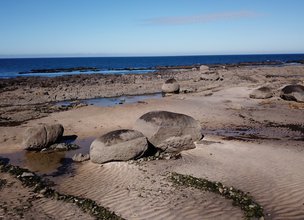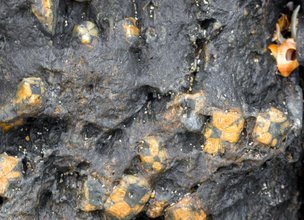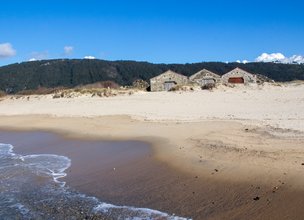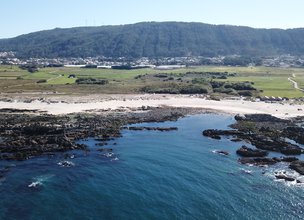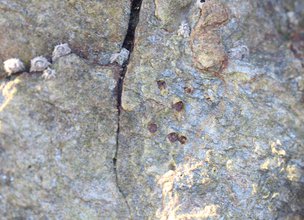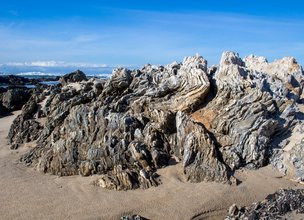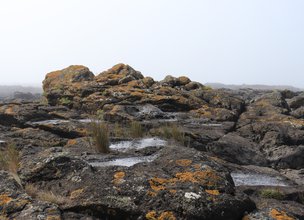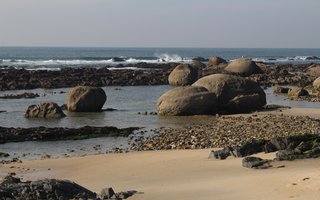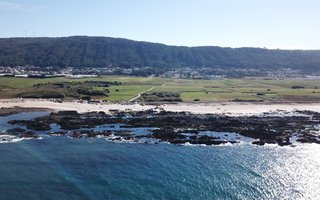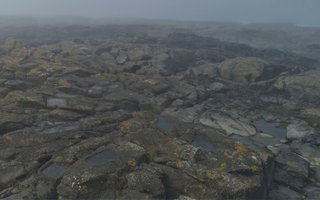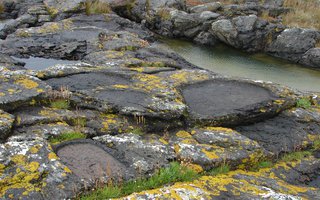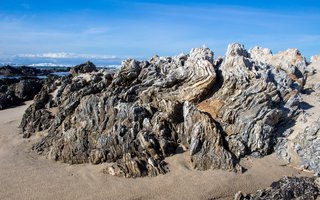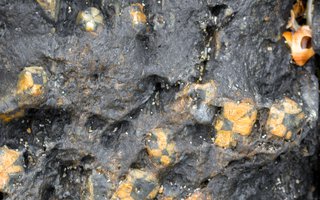Pervasive magma migration
The Magmatic Drops in Canto Marinho Local Natural Monument offers some of the most exclusive aspects of the Viana do Castelo coast, at an archaeological level as well as geological with elements of residual, mineral, tectonic and sedimentologic interest.
In this monument’s area, there occur more than 700 saltpans (Costa et al., 2012) which relevance, beyond archaeological, is in the fact that they could be used as indicators for the coastline position during the pre-Roman period. The rounded granite boulders have residual interest. They are an excellent example of the regional magmatic installation mechanism, namely the pervasive migration of magma. In terms of mineralogical interest, the occurrence of typical assembly of contact metamorphism (medium grade), like garnet and staurolite, which are exclusive in this coastal area of Viana do Castelo is highlighted. They indicate (like the tectonic evidences such as folding occurrences with a very inclined axial plan) the pressure and relevance of heat transfer resulting from the proximity to the Bouça de Frade Plutonite’s intrusion (main coastal outcrop at the Alcantilado de Montedor). In this area, structures are also present that, at a geological timescale, are really recent. Beyond the rock’s flattened tops, that are remains of pre-existing beaches from the last interglacial period (125 thousand years old), sediments of an ancient lake, which endured in this landscape during around 7 thousand years (from 18000 to 11000 years old), are conserved, filled by the spring fusion waters produced by the melting snow of local hillsides.
The Magmatic Drops in Canto Marinho Local Natural Monument offers some of the most exclusive aspects of the Viana do Castelo coast, at an archaeological level as well as geological with elements of residual, mineral, tectonic and sedimentologic interest.
In this monument’s area, there occur more than 700 saltpans (Costa et al., 2012) which relevance, beyond archaeological, is in the fact that they could be used as indicators for the coastline position during the pre-Roman period. The rounded granite boulders have residual interest. They are an excellent example of the regional magmatic installation mechanism, namely the pervasive migration of magma. In terms of mineralogical interest, the occurrence of typical assembly of contact metamorphism (medium grade), like garnet and staurolite, which are exclusive in this coastal area of Viana do Castelo is highlighted. They indicate (like the tectonic evidences such as folding occurrences with a very inclined axial plan) the pressure and relevance of heat transfer resulting from the proximity to the Bouça de Frade Plutonite’s intrusion (main coastal outcrop at the Alcantilado de Montedor). In this area, structures are also present that, at a geological timescale, are really recent. Beyond the rock’s flattened tops, that are remains of pre-existing beaches from the last interglacial period (125 thousand years old), sediments of an ancient lake, which endured in this landscape during around 7 thousand years (from 18000 to 11000 years old), are conserved, filled by the spring fusion waters produced by the melting snow of local hillsides.
Location
This place should be visited with some caution, because depending on the sea conditions, geosites may not be visible. Try to visit at low tide and with a calm sea.
Coordinates
Lat: 41.7346671
Long: -8.8728486
Themes
Discover all the themes of Magmatic Drops of Canto Marinho
Ecological Recovery
The following proposal was presented by the Mayor of the Chamber:- "PROPOSAL - Cooperation Protocol within the scope of the Progama de Reabilitação de Áreas Classificadas do concelho de Viana do Castelo - Responsabilidade ambiental no âmbito das áreas classificadas do concelho de Viana do Castelo".
In the scope of the Municipal Strategy for Nature Conservation, a plan inscribed in the ongoing Environment and Biodiversity Agenda for the four-year period 2017-2021, the Municipality prepared the Programa de Reabilitação Ecológica das Áreas Classificadas do concelho, in this first phase, focusing on 5 of the 13 Natural Monuments, unique areas for the knowledge of the geological history of the Iberian Peninsula since more than 500 million years ago and which are part of the application that the Municipality is preparing for recognition as a UNESCO World Geopark territory. Viana do Castelo is a rich territory from the point of view of Natural and Cultural Heritage, with about 4,800 hectares specifically designated for the protection of fauna and flora habitats (3 sites of Community importance of Natura 2000 Network), being the only municipality in the country with the geological heritage inventory concluded and duly classified with 13 natural monuments, making up a total area of about 2,832 hectares. The recovery programme that was drawn up supported an application to PO SEUR, with approval of the overall investment amount of 500,000 euros, financed at 85%, with implementation in 2020 and 2021. The ecological recovery interventions that are intended to be carried out include actions to eradicate and control exotic species, mainly Acacia dealbata (Mimosa), Acacia longifolia (Acacia longifolia) and Acacia Melanoxylon (Australia), Carpobrotus edulis (beach weevil), Arundo donax (giant reed), Trandescantia fluminencis (Fortune grass or tradescância) and Cortaderia selloana (pampas grass or plumas). In addition to these actions, supported by an exhaustive inventory carried out by the Municipality for those species, the programme includes actions to promote scientific literacy to the population and the densification of the Municipality's Citizen Science strategy, extending the Bioregisto platform to the cartography of invasive vegetation, in collaboration with the Functional Ecology Centre of the University of Coimbra (invasoras.pt). In addition, planting actions are planned in the areas to be ecologically intervened, namely native species such as oak, pine, hawthorn, holm oak, birch or heather, among others, within the scope of the Municipal Year for the Recovery of Portuguese Native Forests, currently underway. In order to guarantee the perennial success of the intervention and the investment made, the rehabilitation programme foresees the involvement of the social and business fabric, and within the scope of the environmental responsibility of the institutions, so that they may take responsibility for the maintenance of the ecological quality of all or parts of the classified areas of the municipality of Viana do Castelo. The programme for the ecological rehabilitation of the classified areas of Viana do Castelo - 1st phase - was carried out with the collaboration of the Parish Councils of Afife, Carreço, Darque, Vila Nova de Anha and Santa Marta de Portuzelo, and also with the Parish Councils of Mazaferes and Vila Fria and the Parish Councils of Viana do Castelo (Santa Maria Maior and Monserrate) and Meadela. The Associação de Caçadores de Vila Nova de Anha and the Comissão Diretiva dos Baldios da Montaria were also partners.
The following proposal was presented by the Mayor of the Chamber:- "PROPOSAL - Cooperation Protocol within the scope of the Progama de Reabilitação de Áreas Classificadas do concelho de Viana do Castelo - Responsabilidade ambiental no âmbito das áreas classificadas do concelho de Viana do Castelo".
In the scope of the Municipal Strategy for Nature Conservation, a plan inscribed in the ongoing Environment and Biodiversity Agenda for the four-year period 2017-2021, the Municipality prepared the Programa de Reabilitação Ecológica das Áreas Classificadas do concelho, in this first phase, focusing on 5 of the 13 Natural Monuments, unique areas for the knowledge of the geological history of the Iberian Peninsula since more than 500 million years ago and which are part of the application that the Municipality is preparing for recognition as a UNESCO World Geopark territory. Viana do Castelo is a rich territory from the point of view of Natural and Cultural Heritage, with about 4,800 hectares specifically designated for the protection of fauna and flora habitats (3 sites of Community importance of Natura 2000 Network), being the only municipality in the country with the geological heritage inventory concluded and duly classified with 13 natural monuments, making up a total area of about 2,832 hectares. The recovery programme that was drawn up supported an application to PO SEUR, with approval of the overall investment amount of 500,000 euros, financed at 85%, with implementation in 2020 and 2021. The ecological recovery interventions that are intended to be carried out include actions to eradicate and control exotic species, mainly Acacia dealbata (Mimosa), Acacia longifolia (Acacia longifolia) and Acacia Melanoxylon (Australia), Carpobrotus edulis (beach weevil), Arundo donax (giant reed), Trandescantia fluminencis (Fortune grass or tradescância) and Cortaderia selloana (pampas grass or plumas). In addition to these actions, supported by an exhaustive inventory carried out by the Municipality for those species, the programme includes actions to promote scientific literacy to the population and the densification of the Municipality's Citizen Science strategy, extending the Bioregisto platform to the cartography of invasive vegetation, in collaboration with the Functional Ecology Centre of the University of Coimbra (invasoras.pt). In addition, planting actions are planned in the areas to be ecologically intervened, namely native species such as oak, pine, hawthorn, holm oak, birch or heather, among others, within the scope of the Municipal Year for the Recovery of Portuguese Native Forests, currently underway. In order to guarantee the perennial success of the intervention and the investment made, the rehabilitation programme foresees the involvement of the social and business fabric, and within the scope of the environmental responsibility of the institutions, so that they may take responsibility for the maintenance of the ecological quality of all or parts of the classified areas of the municipality of Viana do Castelo. The programme for the ecological rehabilitation of the classified areas of Viana do Castelo - 1st phase - was carried out with the collaboration of the Parish Councils of Afife, Carreço, Darque, Vila Nova de Anha and Santa Marta de Portuzelo, and also with the Parish Councils of Mazaferes and Vila Fria and the Parish Councils of Viana do Castelo (Santa Maria Maior and Monserrate) and Meadela. The Associação de Caçadores de Vila Nova de Anha and the Comissão Diretiva dos Baldios da Montaria were also partners.


Hello little one!
I'm Piquinhos and I can help you learn more about the Geopark!
Technical details
Child Mode
Discover the geopark in a simpler format, aimed at the little ones.
Clique ENTER para pesquisar ou ESC para sair
